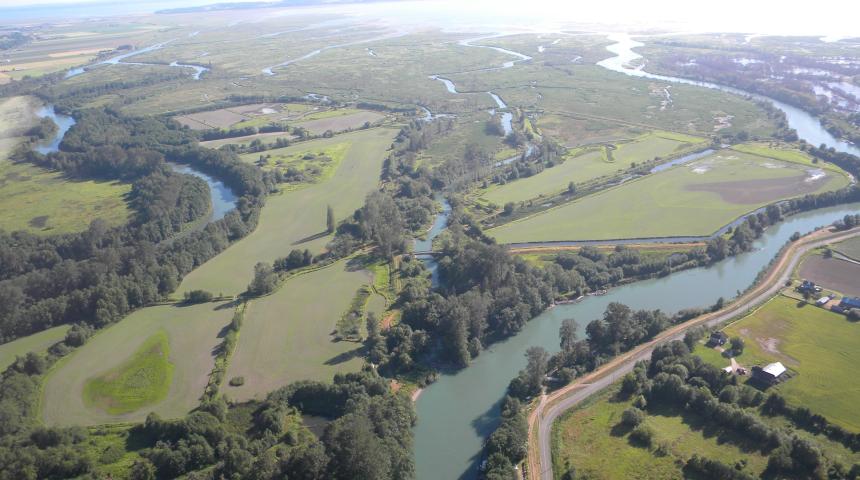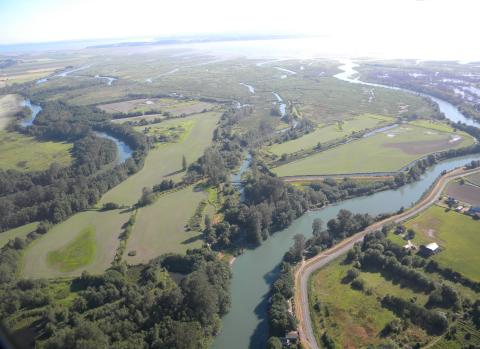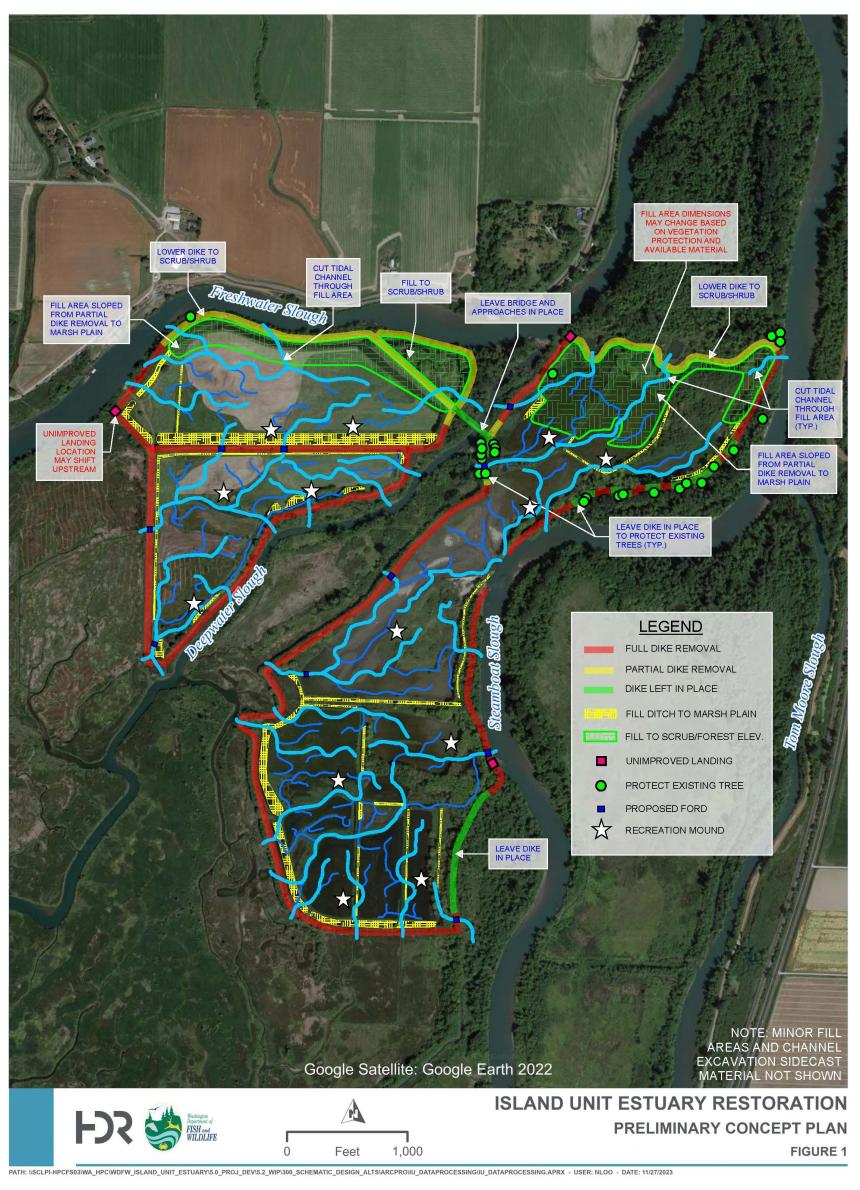- July 1, 2024: The preliminary design (PDF) is complete and final design and permitting have begun. Final design is scheduled to be complete by December 2025. Partial construction funding is in hand from the NOAA Restoration Center using Federal funds from the Bipartisan Infrastructure Law. Additional construction funds are being sought. Weed control work will be ongoing on site until construction occurs. The site remains open for recreation.
Read all project updates below.
The department is moving forward with the Island Unit Restoration Project to restore critical estuary habitat for struggling salmon populations. Historically, the site was a tidally influenced estuary that provided rearing habitat for juvenile Chinook salmon.
The Island Unit covers approximately 270 acres on two islands in a reach of the South Fork Skagit River within the 17,000-acre Skagit Wildlife Area. Dikes and tide gates keep tides and river flows off the site, making it possible to produce high calorie forage for waterfowl.
Since the 1950s, WDFW has managed the Island Unit to provide agricultural crops to enhance food resources for wintering waterfowl. The Island Unit is a popular and productive waterfowl hunting destination that is valued by local and regional waterfowl hunters.
Changes at the site and on the broader landscape, including aging tide gates and dikes, anticipated sea level rise, and shifting habitat needs prompted the department to evaluate alternative land management options, such as removing dikes and tide gates and restoring the site back to estuary. Specifically, additional estuary habitat is needed to recover threatened Chinook salmon.
WDFW assessed four land management alternatives for the Island Unit, ranging from no restoration to restoring all 270 acres. The department evaluated alternatives based on state requirements and policies, fish and wildlife needs, community values, and climate resilience.
An advisory group provided input throughout the alternatives analysis process. In addition, WDFW held a public comment period on a Draft Alternatives Analysis Report from Nov. 16 to Dec. 16, 2020.
In the final Skagit Wildlife Area Island Unit Alternatives Analysis Report, the Department’s North Puget Sound regional management team selected the option to restore all 270 acres of the Island Unit to estuary. They selected the full restoration option because it has the clearest path to implementation, supports threatened species, and has the broadest suite of benefits. However, full restoration means there is a tradeoff of impacts to waterfowl hunting and the loss of enhanced waterfowl forage at the site.
The dike on the east lobe of the Island Unit failed during a high-water event on Nov. 15, 2021, opening a portion of the unit to inundation by tides and river flows. Flood flows may have also caused damage to dikes on the west lobe of the unit. Aerial visuals from drone flights in early 2022 will help WDFW monitor the situation and provide important insights to inform ongoing management and restoration.
Project benefits
Full restoration of the Island Unit has the following benefits:
- Significant support of ESA-listed species. Full restoration provides the greatest opportunity for return of estuary functions and benefits to Endangered Species Act (ESA)-listed species. Estuary habitat is a key limiting factor for the recovery of ESA-listed Chinook salmon in the Skagit. The primary prey of ESA-listed Southern Resident killer whales is Chinook salmon, so maximizing acres of estuary at this site will also contribute to orca recovery.
- Clear pathway to implementation. Full restoration would not require compensatory mitigation, which has been a hurdle WDFW has not been able to overcome on past infrastructure replacement efforts at the Island Unit. Full restoration is the most likely alternative to compete well for implementation funding.
- Multiple-benefits. Full restoration received the highest summary ratings for many of the criteria, including multiple WDFW policies, agreements and obligations, fish and wildlife needs, community interests, and climate change resilience. Additionally, modeling predicts that removing levees at Island Unit will lower flood water elevations for 4.5 miles upstream during large flood events.
Community engagement
Events
During the alternatives analysis, WDFW engaged a project advisory group that consisted of salmon recovery, agricultural and recreational stakeholders, tribes and local, state and federal governments. This group reviewed the alternatives, criteria used to compare alternatives and results.
WDFW also provided a public comment period during which we received more than 200 comments. Over 20 organizations from a range of interests including orca and salmon recovery, bird and wetland conservation and agriculture provided letters of support for restoration of all 270 acres at Island Unit.
During the preliminary design phase WDFW received and incorporated input from the following groups:
- A technical committee that included restoration practitioners and scientists to ensure the best available science was incorporated into the project,
- The neighboring dike and drainage district to ensure their concerns about coastal storm protection were addressed, and
- Recreational users and the public regarding recreational access features to incorporate.
Media
- News release: Feb. 24, 2021
- News release: Nov. 16, 2020
- News release: July 29, 2019
Resources
Maps
Publications
Frequently asked questions
To learn more about the project, please review our Frequently Asked Questions page, as well as our handout (PDF) on the value of estuary habitat restoration for Skagit Chinook salmon recovery.
Contact
Subscribe to email updates
To receive periodic updates about the project, please subscribe to our mailing list by filling out the form below.
Contact information
For more information about the Island Unit Restoration Project, please contact Jenny Baker at Jenny.Baker@dfw.wa.gov or 360-855-8325.
Updates
- July 1, 2024: The preliminary design (PDF) is complete and final design and permitting have begun. Final design is scheduled to be complete by December 2025. Partial construction funding is in hand from the NOAA Restoration Center using Federal funds from the Bipartisan Infrastructure Law. Additional construction funds are being sought. Weed control work will be ongoing on site until construction occurs. The site remains open for recreation.


